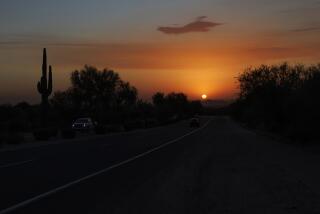Arizona uncorking its own wine country
SONOITA, Ariz. — Images of emerald grape leaves waving in the summer breeze usually don’t fill the pages of Arizona tourism brochures and magazines.
Still, they’re becoming a more common sight as Arizona’s young wine industry grows.
That’s right: Wine is made in Arizona.
I had the same reaction when friends told me about Sonoita, a tiny crossroads about an hour southeast of Tucson, in the southeastern corner of the state brimming with young fields of Mourvèdre and Tempranillo.
With the harvest in, the holiday season approaching and Arizona’s thermostat dropping, year-end is a smart time to visit its wine country.
Speak the name Gordon Dutt and any local winemaker will tell you the story of the man regarded as the father of Arizona winemaking.
Dutt, a onetime soil specialist with the University of Arizona, is credited with noticing that the reddish soil in the hills near Sonoita resembled that in some of Europe’s wine-producing areas.
He experimented with vines in the 1970s and established Sonoita Vineyards, self-titled “Arizona’s first winery.”
There are no teeming crowds and overpriced tastings here. More often than not, the wineries, especially around Sonoita, are simple, no-frills edifices with pragmatic construction. Read: tin siding.
That reflects the passion-over-profit attitude among the state’s winemakers. They know they’re competing with more established and better-known winemaking regions in California, Oregon, Washington and elsewhere.
They are undeterred, even in the face of whipping wind, monstrous summer thunderstorms and the resulting hail, and even bears, which sometimes raid vineyards for a sweet meal.
Marc Moeller smiles even at the mundane task of manually stirring recently crushed grapes, something that must be done to each batch three times a day at Flying Leap Vineyards in the Sonoita area.
“It’s a blend of science and art. That’s why I like it,” the winemaker said, gently handling a metal oar in a plastic crate filled with Mourvèdre. Most of the winery’s work, excepting the de-stemming of the fruit, is done by hand.
Moeller is one of three former Air Force pilots who pooled their resources to take over an existing winery in February and remake it their way. Many of their wines use grapes grown near Sonoita and Willcox, another burgeoning wine region nearer the New Mexico state line.
Winery President Mark Beres grew up in Washington’s wine region, near Walla Walla. After leaving the Air Force, he wanted to take on winemaking, which fascinated him.
“We went into business because a lot of [wineries] are doing things wrong,” Beres said. He and his partners are focusing on growing fewer grapes per acre, which means the resulting fruit makes richer wine.
“We want to make the best wine on the planet, but we want to do it efficiently and economically,” he said.
Thanks to the enthusiasm of Beres and his partners, wine tasters often are invited to see the guts of the business. In autumn, that could mean watching Beres reach his already-purple hands into fermenting grapes. One lucky group visited during a lengthy power outage, with Moeller standing in front of a vat of “berries” — as winemakers call the grapes — needing to be crushed.
Moeller said they decided to get the work done the old-fashioned way: “We went and took our shoes off and got right in.”
Down the road, Kent Callaghan just wants to talk wine, which is what he does with visitors at Callaghan Vineyards. His studiously produced vintages have been served at presidential state dinners and other high-profile events.
Callaghan’s vineyards were among the first to be planted in the Sonoita-Elgin area — in 1990, the summer that 120-degree-plus temperatures shut Sky Harbor Airport in Phoenix. Thanks to its higher elevation, Callaghan’s vineyards suffered under slightly less-hellish temperatures (about 105), still hot enough to cause the young vines to wither. Undeterred, he planted again, using Spanish varieties more accustomed to warm summers.
The result? Several Jefferson Cup medals from the prestigious international competition.
Farther north in the state, not far from Sedona and about a two-hour drive north of Phoenix, the area around Cottonwood is known more for its Mars-hued topography than the handful of vineyards and wineries that have taken up residence.
At the Arizona Stronghold tasting room in Cottonwood, Bree Nation pours with passion in front of the boldly colored state flag with its copper star. Nation said part of the draw of Arizona wine is the satisfaction in “buying local.”
As with many wineries in the northern part of the state, Stronghold’s grapes come from other regions, such as southeastern Arizona and California. Still, they are proud to say their wine is made far from U.S. regions usually associated with fine vintages.
It was enjoyable to contrast them with pure Arizona vintages, some of which I liked, some I didn’t. The ones I disliked didn’t seem to have the complexity of their California counterparts, which I ascribe to the relative youth of the Arizona wine industry. But even when the duds surfaced, the journey was enjoyable, particularly because “Arizona” seems so incongruent with “winery.”
One more thing differentiates Arizona wineries from their California counterparts. In Arizona, most wineries do not reuse the glasses used for tasting. Instead, patrons who don’t have their own glasses buy one at the first winery of the day, usually for about $5. That’s why, in Arizona, it’s not unusual to see seasoned wine tasters carrying glasses into the tasting rooms, ready for the next pour.
More to Read
Sign up for The Wild
We’ll help you find the best places to hike, bike and run, as well as the perfect silent spots for meditation and yoga.
You may occasionally receive promotional content from the Los Angeles Times.






